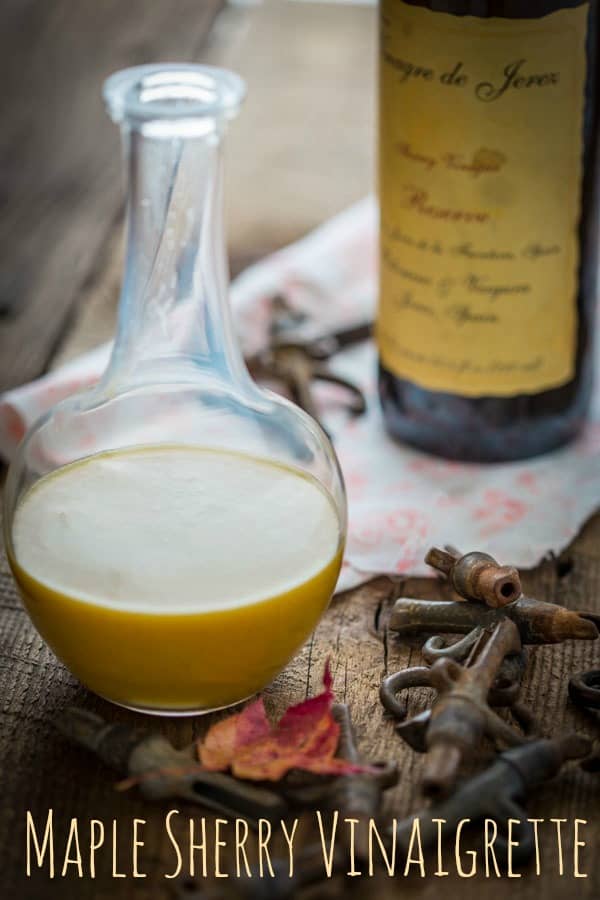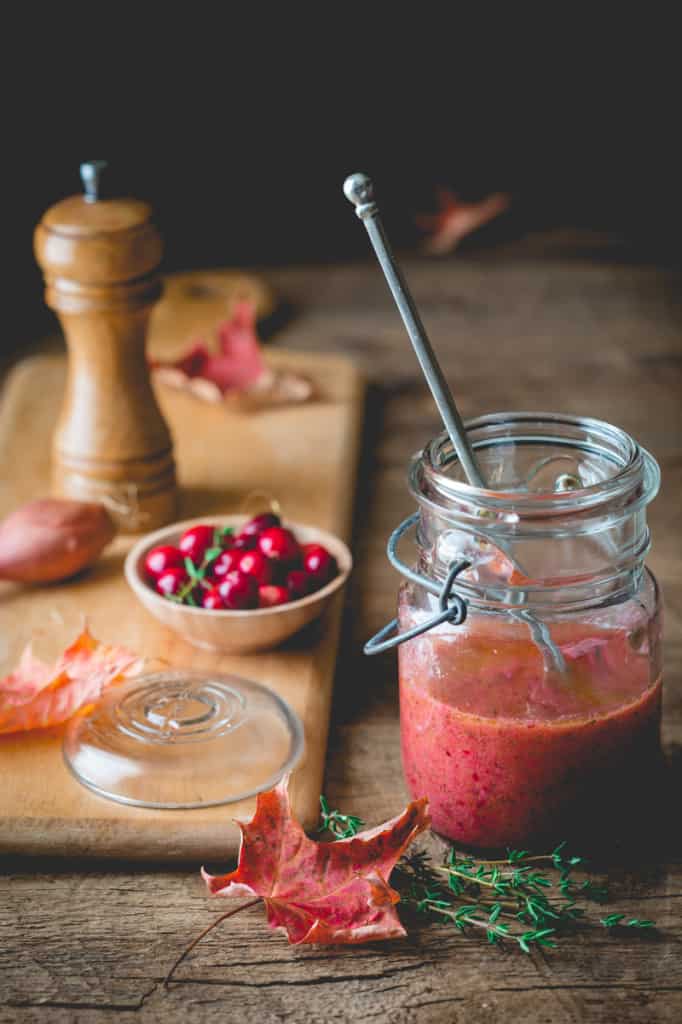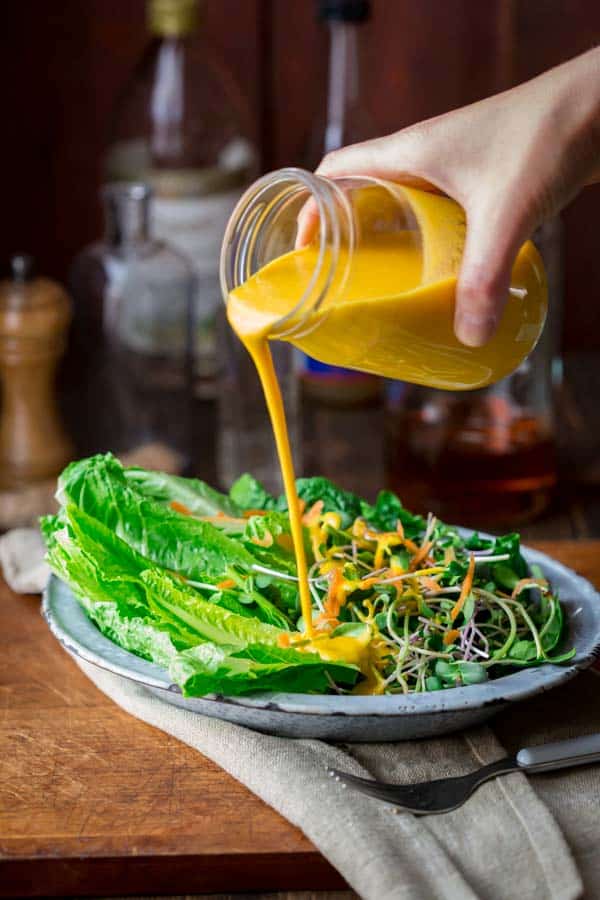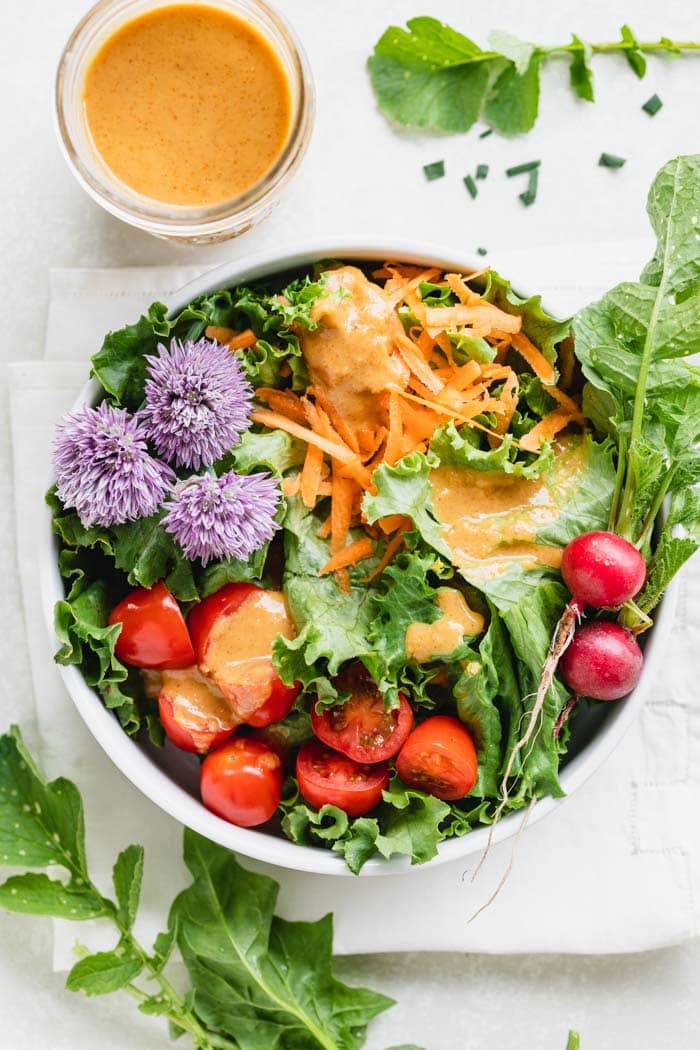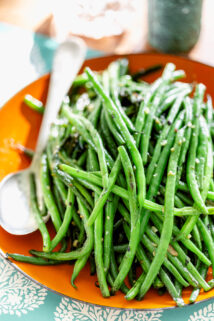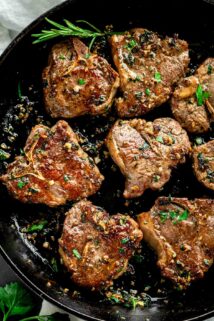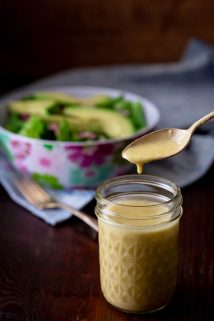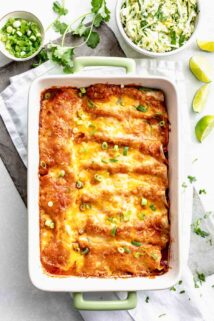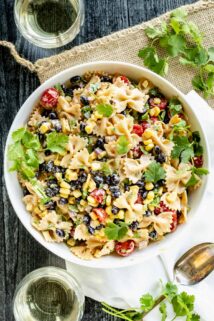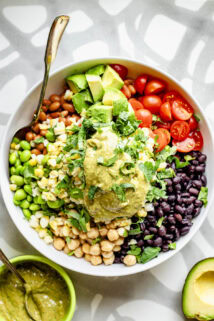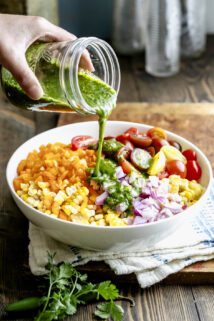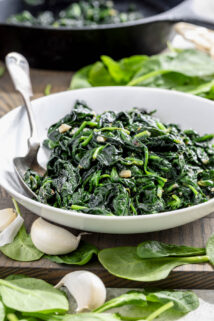25 Homemade Salad Dressing Recipes
Say no thank you to store-bought salad dressings and hello to easy delicious homemade vinaigrettes and creamy dressings. Your salad bowl will be forever inspired and your taste buds will thank you when you try these salad dressing recipes!

This post contains affiliate links
Table of contents
Give us a bowl of fresh leafy greens and we’ll make you a different salad for every day of the week. Heck, we don’t even need greens to make a great salad. But one thing is for sure, you need a great homemade salad dressing recipe to take your salad to the next level.
From gourmet vinaigrettes like Cranberry Dressing, Kalamata Basil, and Carrot Ginger Dressing to classics like Caesar Salad Dressing, Ranch Dressing, Lemon Vinaigrette, French-inspired shallot vinaigrette with red wine vinegar, and our popular Apple Cider Vinaigrette too!
Once you’ve looked at all of these amazing salad dressing recipes, don’t forget to check out our featured recipe, number 25 on our list. This quick, 5-minute Orange Miso Salad Dressing is bursting with bright, fresh flavors, and whether you drizzle over a tasty Buddha bowl or dress some chopped cabbage or simple greens, it’s sure to turn any dish into a delight!
Jump To Homemade Salad Dressing Recipes
Expert Tips for Making Homemade Salad Dressing
Here is our guide to the essential elements for a delicious homemade salad dressing:
Acid
- First, you start with the acidic element. The acidic ingredient gives the dressing tanginess, brightness, or a sour taste.
- Sour is important to add to dressing because greens are inherently bitter (though to varying degrees) and sour balances bitter.
- Many dressings get their acidity from vinegar, like this cider vinegar dressing.
- There are of course other acidic ingredients used in dressings such as fruit juices, citrus, buttermilk, and yogurt.
Fat
- There certainly are dressings made without fat, but most have fat in them in equal or greater proportion to the acidic ingredient. The oil carries the flavors of the other ingredients and makes their flavors more pronounced (i.e. fat is flavor!)
- Oils, and oil emulsions like mayonnaise, and dairy fat (like sour cream) are the most common fats used. Nut butter and ground seeds (like tahini) are other less traditional fats used in dressing.
- From a nutritional standpoint, fat is important to help us absorb and digest nutrients in our salads and they also provide satiety. But at 120 calories per tablespoon of oil, we mustn’t go overboard with them.
- I try to keep the fat at about 50% or less of the total volume of dressing. Yogurt and buttermilk in creamy dressings and optional ingredients in both creamy dressings and vinaigrettes (see below) are ways to keep the fat ratio at 50% or less.
Allium
- I rarely make salad dressing without some form of allium in it. I try to keep things simple and not use more than one. And I like to use a light hand with whichever one I am using.
- In the case of this cider vinegar dressing, I used shallot. But some other examples of allium in dressing are garlic (and granulated garlic and roasted garlic), onion, and chive.
- This is not necessary, but in small amounts, allium adds so much to a dressing.
Emulsifiers
An emulsifier is an ingredient that makes oil and water hold together. These are useful in salad dressings because they keep the ingredients in suspension.
- The two most common emulsifiers in homemade salad dressings are mustard and egg yolk.
- I also am a fan of using my blender or mini prep to blend my dressings, which can make the temporary emulsions hold longer. See more below about blending techniques.
- FYI, commercially bottled dressings commonly use soy lecithin which is a soy-derived emulsifier.
Optional Ingredients
- These are ingredients that are added to dressings like roasted tomatoes, cheese, peanut butter, fruit, pesto, and fresh herbs that make them flavorful and unique.
- Some optional ingredients like Greek Yogurt are all about making the dressing creamy and have a nice thick texture and mouth-feel. Try Greek Yogurt Ranch or Healthy Blue Cheese Dressing.
- Other optional ingredients, like chopped herbs, add a big punch of flavor. Others like tahini add flavor and creaminess!
- I find that I like to add a little bit of something sweet to a lot of my dressings. Again this in part has to do with the ratio of fat.
- Honey, maple syrup, and agave are great ways to add a balancing sweet note because they are already liquid.
- Naturally sweet fruits like raspberries can also do this very well. Sweetness is not required, so that’s why it falls into the optional category.
Healthy Tip: These optional ingredients can also help extend a dressing (increase the volume) without adding more fat.
Salt and Pepper
- If you use soy sauce, miso (see our featured recipe below), capers, fish sauce, or another salty ingredient you can get away without adding more salt or very little.
- Keep in mind that if you don’t have salt to balance the acidity, your dressing will seem too strong. This is especially important in lower-fat dressings that do not have bulking ingredients added.
- I am a huge pepper lover. I usually add pepper to my dressings and the salad too at the table.
- Consider the ingredients in your salad before you season. If you have Parmesan or feta in the salad, season the dressing lightly, then taste the salad once it is tossed, and add more salt if the salad needs it.
25 Salad Dressing Recipes
Simple yet delicious, this easy homemade Lemon Vinaigrette dressing pairs perfectly with a variety of salad combinations. This tasty dressing has just the right balance of acidity with a touch of sweetness - it'll be a tart and refreshing addition to your favorite salad!
Maple Sherry Vinaigrette tastes amazing on any salad plus it's refined sugar-free, paleo, gluten-free, and vegan!
Homemade Walnut Balsamic Vinaigrette is a simple yet delicious and interesting dressing to have on hand as it goes with a variety of flavors and salad combinations. Best part? It's naturally gluten-free and vegan!
A culinary chameleon, this Maple Balsamic Vinaigrette highlights just about any combination of salad ingredients. This dressing is so flavorful that your guests will be asking you for a copy of the recipe!
Spice up a basic oil and vinegar salad dressing by adding some tarragon! This Tarragon Vinaigrette is a revelation - drizzle over your favorite salad or steamed veggies and you'll see what we mean.
Whether you want to switch up your usual salad routine or need something special to serve on your holiday table, this healthy, easy Cranberry Vinaigrette is just that! This vegan dressing made with fresh cranberries, chopped thyme, and shallots is naturally tart and pairs beautifully with almost any autumn dish.
Add kalamata olives and basil to jazz up a simple oil and vinegar salad dressing. This easy, gluten-free, paleo, vegan vinaigrette is ready in 10 minutes and will quickly becomes your go-to spring and summer dressing.
5-minute, homemade Apple Cider Vinegar Salad Dressing is simple to make and healthier than bottled. This delicious dressing is the perfect make-ahead recipe that is easily customizable and tastes amazing with a variety of salad combinations!
This Red Wine Vinaigrette is a 5-minute culinary chameleon. Made with a few basic kitchen staples, is easy to make and has the perfect amount of tang. Pour this dressing over your favorite salad and get ready to be wowed!
Need a delicious savory dressing? Then look no further! Our simple Asian Sesame Salad Dressing gets a touch of sweetness from a dash of maple syrup. Drizzle over your favorite salad or veggies and get ready to wake up those tastebuds!
This Maple Tahini Dressing takes only 5 minutes to whip up, is vegan, gluten-free, paleo, and it's versatile! Enjoy this creamy dressing over your favorite bed of greens, as a delicious dip, or as an irresistible sauce for grilled fish.
Ready in under 10 minutes, this Carrot Ginger Salad Dressing tastes like the dressing served at Japanese steakhouse restaurants. This bright orange, zesty, gingery condiment tastes good on pretty much anything. So go ahead, enjoy with crisp veggies, drizzle over your salad, or even serve alongside grilled chicken. No matter how you eat it, you can't go wrong.
Green Goddess Dressing, the Throwback Classic Dressing You Need to Make
Green Goddess Dressing is a classic! Loaded with fresh green herbs and blended with sour cream, this recipe can either be served as a dip with crudités or lightly tossed over a bed of greens for a refreshing, healthy bite.
When you're craving a restaurant-style Caesar but don't want to leave your home, this classic Caesar salad dressing is for you! This easy-peasy, 5-minute recipe is a homemade dressing that is sure to be the star of your Caesar salad bowl!
This Healthy Greek Yogurt Ranch Dressing is low in calories and fat but not low in flavor! This homestyle ranch is simple to make and bursting with that classic homestyle ranch flavor that we all know and love.
This light and creamy Italian Dressing is a delicious alternative to those low-fat store-bought bottled dressings. This easy-to-make recipe is ready in under 10 minutes and is only 59 calories per serving!
Blue Cheese Dressing got a healthy makeover! We swapped out some of the mayo for Greek Yogurt so it's only 63 calories per serving, but is still creamy, slightly chunky, and full of that iconic blue cheese flavor! Drizzle over a wedge salad or serve on the side of some spicy Buffalo Wings for one cooling bite.
Creamy Cilantro Lime Dressing is so much better than store-bought! All you need is a handful of ingredients and 10 minutes to whip up this creamy, flavorful dressing. Toss over a simple bed of greens, or spice up tacos, veggies, chicken, fish, or steak with a little drizzle on top!
This easy homemade Peanut Dressing is inspired by classic Thai flavors and goes with a variety of salad combos!
Creamy Avocado Dressing uses a handful of ingredients and only takes 5 minutes to make. Full of healthy fats, this thick and delicious dressing will definitely vamp up your favorite bed of greens.
This Easy Lemon Tahini Salad Dressing is vegan-friendly and whole30-approved! It takes less than 5 minutes to make and can quickly transform a basic salad into a delicious meal or drizzle over a Buddha bowl as a healthy and delectable condiment.
Thai-inspired Honey Sriracha Lime Dressing is simple to make and bursting with flavor. It's the perfect combination of sweet and sour and just what you need when you want to spice up your simple bed of greens.
Homemade Thousand Island Dressing is a sauce you need to have in your fridge! Tangy yet slightly zesty, this gluten and dairy-free dressing is the perfect condiment for your next burger or poured over your favorite salad combination.
This homemade Catalina Dressing tastes just like your favorite store-bought version but better! Made with a handful of pantry staples this dressing is easy to make and tastes amazing not only on your favorite salad combination but on that juicy piece of grilled chicken.
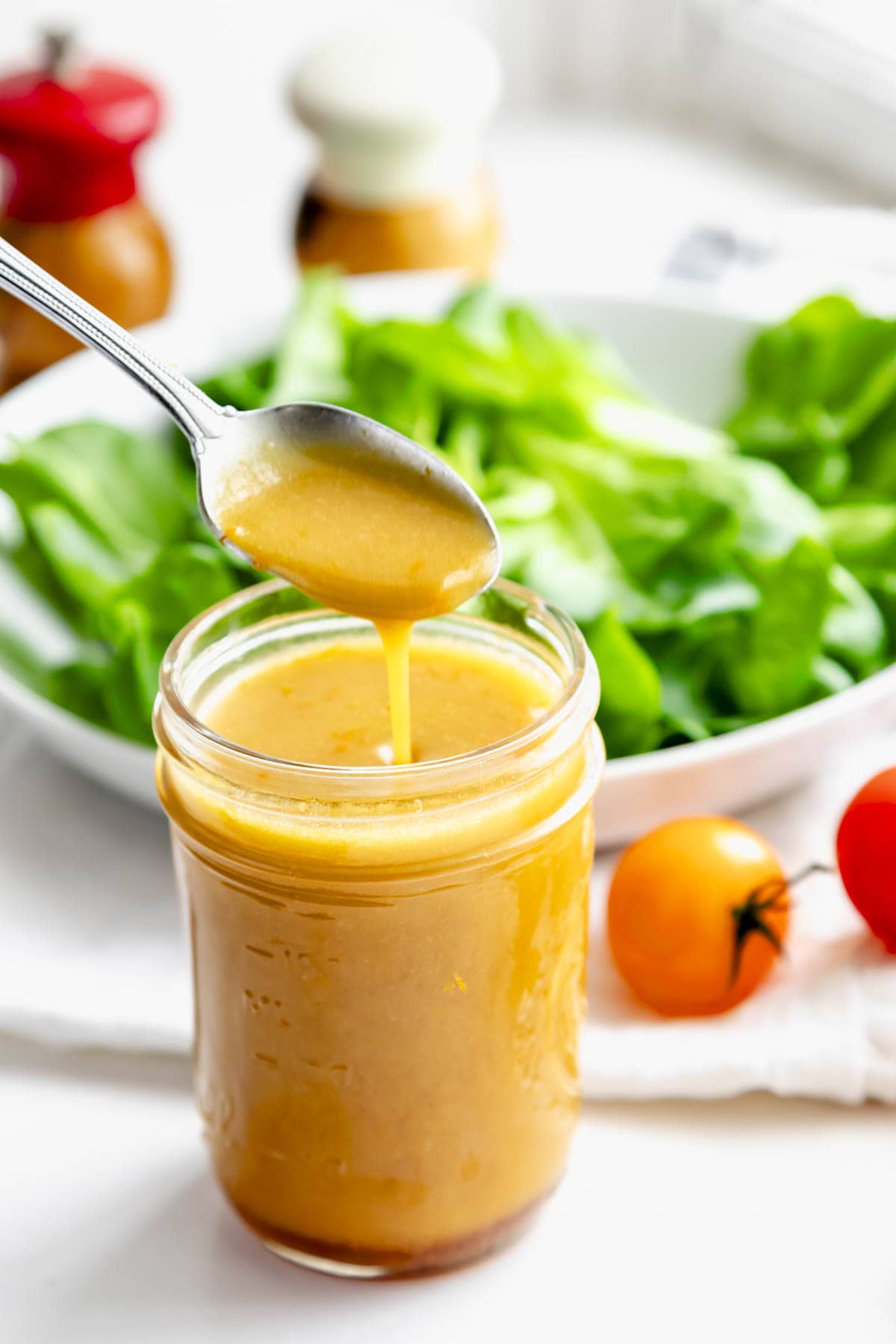
How Long Does Homemade Dressing Last?
In general homemade dressing can be kept in the refrigerator for 4 days and up to 1 week. Keep in a jar or sealed container. Make sure to check with the instructions and tips for the specific recipe you are using some will go bad more quickly than others. Shake well before using.
Do I have to refrigerate salad dressing?
Unless your dressing is made with only oil and vinegar, you should refrigerate it due to the inclusion of perishable ingredients such as garlic, herbs or dairy.
Additionally, while both oil and dried herbs, for example, are shelf stable on their own, when in combination they create conditions that can encourage the growth of botulism.
So we say, be safe and refrigerate your dressing!
What is the best way to store homemade salad dressing?
I usually store it in a wide mouth pint sized ball jar or half pint jam jar. You can also buy a reusable dressing cruet or bottle with a convenient pour top.
Why Did My Dressing Harden In the Fridge?
Olive oil based salad dressing will solidify in the refrigerator due to their high level of monounsaturated fats. If the dressing solidifies in the refrigerator, let it come to room temperature and then shake well. Alternatively you can bring it back to a liquid state by setting the jar of dressing in a bowl of warm tap water. Shake the jar every minute or two until the mixture is liquid again.
What To Serve With Salad
- We love soup and salads. Try out some of these healthy soup recipes.
- Another classic combo is salad and sandwiches. Here is our collection of sandwich recipes here on Healthy Seasonal Recipes.
- We love a baked item with our salad. Try Cornbread Muffins or Whole Wheat Bread fresh from the oven.
Thanks so much for reading! If you are new here, you may want to sign up for my email newsletter to get a free weekly menu plan and the latest recipes right to your inbox. If you make this recipe, please come back and leave a star rating and review. I would love to hear what you thought!
Happy Cooking! ~Katie

Orange Miso Salad Dressing
- Total Time: 5 minutes
- Yield: 7/8 cup 1x
Description
This 5-minute dressing will turn a bowl of chopped cabbage or simple fresh greens with garden veggies into a delight.
Ingredients
- 1 teaspoon orange zest
- 2 tablespoons freshly squeezed orange juice
- 2 tablespoon dark pure maple syrup
- 1 tablespoon white vinegar
- 1 tablespoon miso paste, preferably white miso
- 1 tablespoon reduced-sodium soy sauce or tamari
- 1/2 teaspoon granulated garlic
- 1/4 teaspoon freshly ground pepper
- 1/3 cup extra-virgin olive oil
Instructions
- Whisk orange zest, orange juice, maple syrup, vinegar, miso, soy sauce or tamari, garlic, and pepper in a medium bowl.
- Whisk in oil.
Notes
To make ahead: store in the refrigerator for up to 4 days in a tightly sealed jar.
- Prep Time: 5 minutes
- Category: Dressing
- Method: Blended





